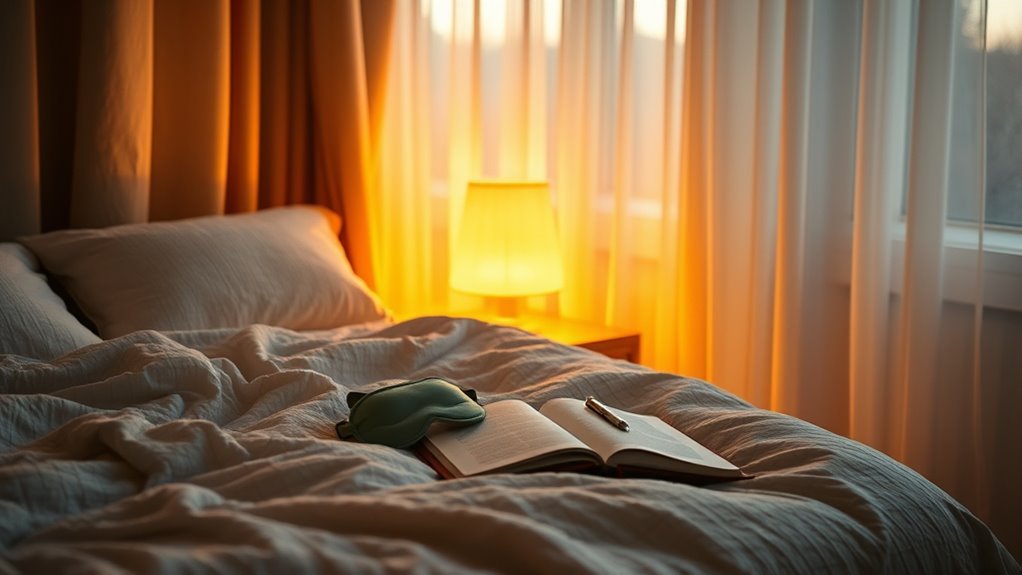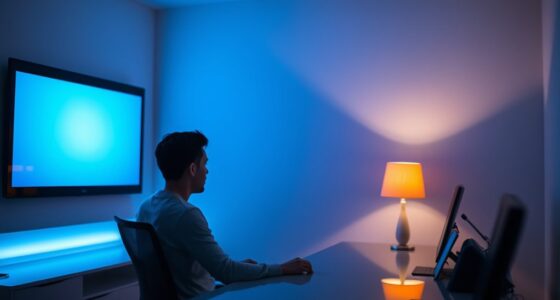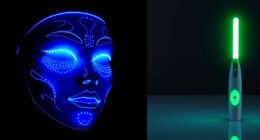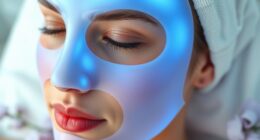To reset your circadian rhythm, switch to amber or warm-colored lights an hour or two before bed. This signals your body that it’s time to wind down, boosting melatonin production and improving sleep quality. Avoid blue light from screens and bright overhead lighting during this time. Creating a dim, cozy environment helps your body shift seamlessly into sleep. Keep these tips in mind, and you’ll discover more ways to optimize your nightly rest.
Key Takeaways
- Replacing evening bright lights with amber or warm-colored bulbs signals your body to produce melatonin naturally.
- Using amber lighting an hour or two before bed helps create a relaxing environment that promotes sleep readiness.
- Incorporate blue light filters or glasses on devices in the evening to prevent melatonin suppression.
- Consistently managing evening lighting aligns your circadian rhythm with natural sunset cues, improving sleep quality.
- These lighting strategies lead to deeper, restorative sleep and support overall health by resetting your internal clock.
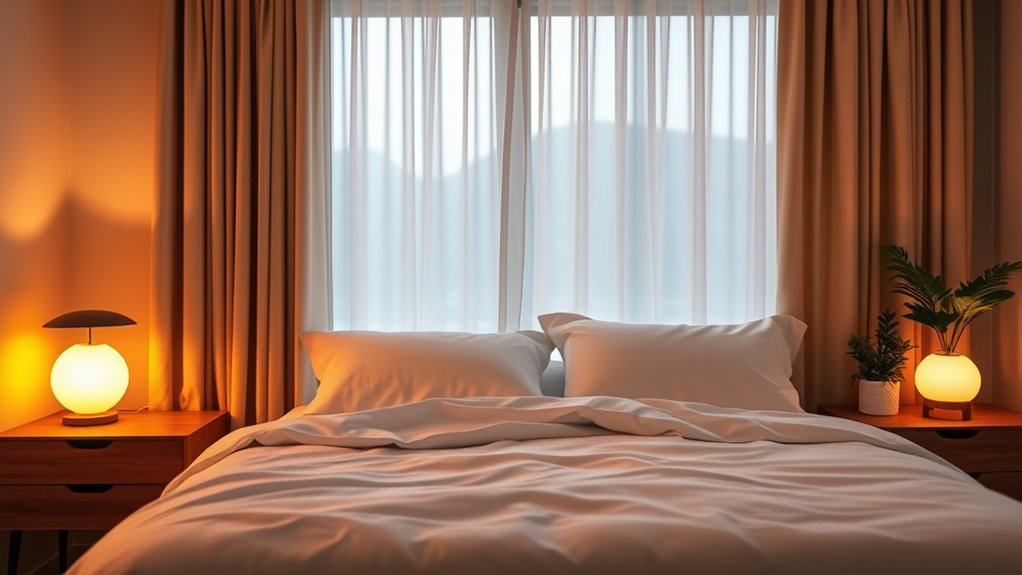
Have you ever wondered how a simple change can drastically improve your sleep quality? One of the most effective ways to do this is by managing your evening light exposure. Our bodies are wired to follow a natural circadian rhythm, a 24-hour internal clock that regulates sleep and wakefulness. This rhythm is heavily influenced by light, especially during the evening hours. When you’re exposed to bright or blue light late in the day, it can disrupt this cycle, suppress melatonin production, and make falling asleep harder. Conversely, controlling your evening light exposure, particularly by incorporating amber or warm-colored lights, can help signal your body that it’s time to wind down. This adjustment allows your melatonin levels to rise naturally, making you feel sleepy and ready for rest.
Your body produces melatonin, often called the sleep hormone, in response to darkness. As evening approaches, melatonin levels increase, signaling to your brain that it’s time to prepare for sleep. But in today’s world, many of us are exposed to artificial lighting and screens that emit blue light, which tricks your brain into thinking it’s still daytime. This suppresses melatonin production, delaying sleep onset and reducing sleep quality. By intentionally using amber or dim, warm-colored lights during your evening hours, you help mimic natural sunset conditions. This not only minimizes blue light exposure but also encourages your body to ramp up melatonin production. The result is a smoother transition from wakefulness to sleep, with less tossing and turning.
Using amber lights in the evening boosts melatonin and promotes better sleep.
To implement this, start by replacing bright overhead lights with amber or red bulbs in your living space an hour or two before bed. If you use electronic devices, consider installing blue light filters or glasses designed to block blue wavelengths. Creating a dim, cozy environment signals your brain that it’s time to relax, aiding the natural rise in melatonin. Over time, these small adjustments will help reset your circadian rhythm, making it easier for you to fall asleep at your desired time and wake up feeling more refreshed. Additionally, integrating advanced sleep science can optimize your nightly rest and overall health. You’ll notice that your sleep becomes deeper and more restorative, and you’ll be less dependent on external aids like caffeine or sleep medications.
Incorporating evening amber-light sessions isn’t just about improving sleep—it’s about aligning your body’s natural clock with the environment. This simple change leverages your body’s innate processes to optimize melatonin production, allowing you to enjoy more restful nights and energized mornings. By consciously managing your evening light exposure, you set the stage for better sleep hygiene and a healthier, more balanced life.
Frequently Asked Questions
Can Amber Light Exposure Improve Sleep Quality for Shift Workers?
You might find that light therapy with amber light exposure helps improve your sleep quality as a shift worker. Amber light can promote circadian alignment by signaling your body to prepare for sleep, even if your schedule is irregular. Regular evening sessions can help reset your internal clock, making it easier to fall asleep and stay rested. This simple strategy could enhance your overall sleep and daytime alertness.
How Long Should Each Amber-Light Session Last for Optimal Results?
Research shows that just 30 to 60 minutes of amber-light exposure can considerably improve sleep by resetting your circadian rhythm. For ideal results, follow the duration guidelines of 30-minute sessions, ideally once or twice in the evening. Consistent session frequency helps reinforce your body’s internal clock. Stick to this routine regularly, and you’ll notice better sleep quality and improved alertness during your shifts.
Are There Any Side Effects of Evening Amber-Light Sessions?
You might wonder if evening amber-light sessions have side effects. Generally, they’re safe, but you could experience potential eye strain if your eyes are sensitive or exposed for too long. Some people may notice skin sensitivity, especially if they have sensitive skin or underlying conditions. To avoid issues, keep sessions moderate in duration, take breaks if needed, and listen to your body’s responses. If discomfort persists, consult a healthcare professional.
Is Amber Light Therapy Safe for Children and Teenagers?
They say, “Better safe than sorry,” and when it comes to amber light therapy, safety concerns are valid. For children and teenagers, it’s essential to follow pediatric guidelines and consult healthcare professionals. While generally considered safe, long-term effects aren’t fully understood, so supervision is key. Always make certain the sessions are age-appropriate, and never replace medical advice with self-treatment. Safety first keeps everyone healthy and happy.
How Does Amber Light Compare to Other Light Therapies for Circadian Rhythm?
You’ll find amber light therapy effective because it emits a narrow light spectrum, mainly in the red to orange range, which minimizes blue light exposure. Compared to other light therapies like blue or white light, amber light is gentler and less likely to disrupt melatonin production. Its therapy efficacy is particularly beneficial for winding down in the evening, helping reset your circadian rhythm without overstimulating your eyes or brain.
Conclusion
By embracing evening amber-light sessions, you’ll discover the secret to a sleep so deep, it’s like drifting into a dreamland where time stands still. Say goodbye to sleepless nights and hello to superhero mornings—your energy will skyrocket, and stress will vanish faster than your favorite snack. It’s a simple trick that transforms your nights into a blissful paradise, making you wonder how you ever survived without this magical, glow-tastic sleep hack. Sleep tight, sleep bright!
